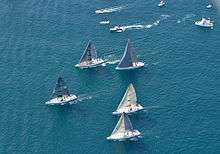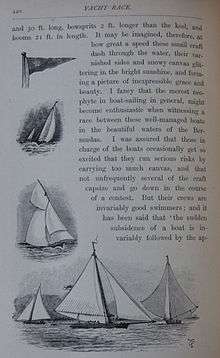Yacht racing

Yacht racing is a form of sport involving yachts and larger sailboats, as distinguished from dinghy racing. It is composed of multiple yachts, in direct competition, racing around a course marked by buoys or other fixed navigational devices or racing longer distances across open water from point-to-point. It can involve a series of races when buoy racing or multiple legs when point-to-point racing.
History

Yachting, that is, recreational boating, is very old, as exemplified in the ancient poem Catullus 4:

The yacht you see there, friends,
says that she's been
The fastest piece of timber ever seen;
She swears that once she could have overhauled
All rival boats, whether the challenge called
For racing under canvas or with oars.
(trans. James Michie)
"Yacht" is referred to as deriving from either Norweigian ("jagt"), Middle Low German ("jaght") or from the Dutch word jacht, which means "a swift light vessel of war, commerce or pleasure. The sporting element in the word lies in the derivation of jaght from the root jaghen, which means to hunt, chase or pursue…."[1][2]
The formal racing of boats is believed to have started with sailboats in the Netherlands some time in the 17th century. Soon, in England, custom-built racing "yachts" began to emerge and the Royal Yacht Squadron was established in 1815. In 1661 John Evelyn recorded a competition between Katherine and Anne, two large royal sailing vessels both of English design, "…the wager 100-1; the race from Greenwich to Gravesend and back."[3] One of the vessels was owned, and sometimes steered, by Charles II, the King of England. The king lost.
In 1782 the Cumberland Fleet, a class of sailing vessel known for its ability to sail close to the wind, were painted racing up the Thames River with spectators viewing from a bridge.[4] Much like today, this obsession with sailing close to the wind with speed and efficiency fueled the racing community.
In the nineteenth century most yacht races were started by allotting starting positions to the competitors. Buoys were laid in a straight line, to which the competitors attached their yachts by means of spring ropes. The yachts were required to keep all the sails forward of the main mast on deck until the starting signal was given. [5] The Yacht Racing Association was founded in 1875 by Prince Batthyany-Strattman, Captain J. W. Hughes, and Mr. Dixon Kemp.[6] The Y.R.A. wrote standardised yacht racing rules which included the 'Flying Start' used today. [7]
Bringing yacht racing to the forefront of public life, the America's Cup was first raced in 1851 between the New York Yacht Club and the Royal Yacht Squadron. Not ruled or regulated by measurement criteria as today, it is the second-place finisher was Aurora, "and but for the fact that time allowance had been waived for the race she would have been the winner by a handsome margin."[8] Subsequently, the Cup races were conducted, usually every 3–4 years, based on a challenge issued by one club to the current Cup holder, which till 1983 was the NYYC.
Rules and ratings


As yacht racing became more prevalent, and yacht design more diverse, it was necessary to establish systems of measurements and time allowances due to the differences in boat design. Longer yachts are inherently faster than shorter ones; therefore, in the interests of fairness, in the 1820s a “primitive system of time allowance was introduced on the Solent.”[9] Larger yachts were handicapped; but owners with the biggest vessels had a problem with the allowance system, for they preferred that crossing the finish line first, much as in foot and horse races, should suffice to win the contest. As a result, both ratings and “one-design” competition were developed.
Ratings systems rely upon some formulaic analysis of usually very specific yacht-design parameters such as length, sail area, displacement, and hull shape. During the 1920s and through the 1970s the Cruising Club of America established a formula by which most racing/cruising boats were designed during that period. After its descendant, the mathematically complex International Offshore Rule (IOR) of the 1970s, contributed to much decreased seaworthiness (and even speed), the simpler Performance Handicap Racing Fleet (PHRF)[10] system was adopted. The PHRF uses only proven performance characteristics, especially theoretical sailing speed, as a means to allow dissimilar yachts—typically crewed by friends and families at clubs rather than by professional crews—to race together. Most popular family-oriented cruising sailboats will have a rating filed with a local chapter of the PHRF.
The most prevalent handicap rating systems today are the ORC, ORR, IRC, and the PHRF.[11] Many countries organise their own handicap systems which do not take into account the size, weight, or sail area of the yacht, but performance is measured on the basis of previous race results. The Irish E.C.H.O. system is such a handicap system.[12]
One-design racing was invented by Thomas (Ben) Middleton in 1886 in Killiney Bay close to Dublin City, Republic of Ireland. Middleton was concerned that winning a yacht race was more reliant on having an expensive new yacht, than it was on the skill of the yachtsman.[13] One design yacht racing is conducted with classes of similar boats, all built—often via mass-production—to the same design, with the same sail area and rig, and the same number of crew, so that crew ability and tactical expertise are more likely to decide a race than boat type, or age, or even weather. Popular racing boats such as The Water Wag, Laser, the J/22 and J/24, the Etchells, and the Star and New York 30 of Nathanael Herreshoff are examples of one-design boats.
In general, modern yacht-racing contests are conducted according to the Racing Rules of Sailing,[14] first established in 1928.[15] Though complex, the RRS are intended primarily simply ensure fairness and safety. The Rules are revised and updated every four years by the body now known as World Sailing.
Notable Races
The major races of today can be classified as offshore, ocean, around the world, and inshore racing all adhering to one set of rule, but diverse handicapping standards.[16]
Offshore races
- Vic-Maui Yacht Race – (Vic-Maui) is an offshore yacht race starting at Victoria in Canada and ending at Lahaina in Hawaii, a distance of 2,308 nautical miles ((4,274 km)). The Vic-Maui race was started in 1965, is held every other year, and is the longest of the Pacific-Hawaii races.
- Transpacific Yacht Race - (Transpac) is an offshore yacht race starting off Point Fermin, San Pedro, near Los Angeles, and ending off Diamond Head Lighthouse in Honolulu, a distance of around 2,225 nautical miles (2,560 mi; 4,121 km). Started in 1906, it is one of yachting's premier offshore races and attracts entrants from all over the world. The race is organized by the Transpacific Yacht Club.
- Fastnet – established in 1924 with 7 boats, the race covers approximately 600 miles starting at Cowes on the Isle of Wight, rounding Fastnet rock on the southern coast of Ireland, and finishing at Plymouth.
- Tour De France A La Voile – established in 1978 with 20 boats, the race parallels the cycling event and takes place along France's three coasts: English Channel, Atlantic Ocean, and the Mediterranean. It covers over 1000 miles.
- Sydney to Hobart Yacht Race – established in 1945, this Australian race runs from Sydney, New South Wales to Hobart, Tasmania covering over 682 nautical miles (1,263 km; 785 mi).[17]
- Melbourne to Hobart Westcoaster- The 440nm course crosses Bass Strait, down the rugged West Coast of Tasmania and rounds the southernmost tip of Australia before heading up the Derwent River to the finish in Hobart.
- Newport to Bermuda – started in 1906 the race runs from Newport, Rhode Island to Bermuda, a small archipelago approximately 640 miles off Cape Hatteras, North Carolina.
- Chicago Yacht Club Race to Mackinac – founded in 1898 with five boats, the race runs from Chicago, IL to Mackinac Island on the northern tip of Michigan covering over 300 miles of freshwater racing.
- Marblehead to Halifax race – founded in 1905, the race runs from Marblehead, Massachusetts to Halifax, Nova Scotia covering over 360 miles of racing.
- Coastal Classic – starting in 1982 this race is New Zealand’s premiere fleet race. Covering about 125 miles, it is shorter than most offshore races and runs north from Auckland to Russell, which is at the northern tip of New Zealand’s North Island.
- San Fernando – this race, started in 1975 with six yachts, runs a distance of 500 miles between Hong Kong and the Philippines.
- The Governor's Cup – this race, started in 1996 with 15 yachts, runs a distance of 1700 miles between Simon's Town in South Africa and St. Helena Island in the South Atlantic.
- Regata del Sol al Sol - established in 1968, this race runs from the St. Petersburg Yacht Club in St. Petersburg, Florida to Isla Mujeres, Mexico, a small island 8 miles Northeast of Cancún in the Caribbean Sea. This race runs a distance of 500 nautical miles. Typically, two dozen or more boats from all over the Gulf of Mexico compete in this regatta, with LOA ranging from 35 to 80 feet.
Ocean classics
- Ostar – first held in 1960, organised by the Royal Western Yacht Club, the Ostar runs from Plymouth to Newport (in 1960 the finish line was in New York). It is a single-handed race, against the prevailing wind and current in the North Atlantic. The race is held every 4 years but has become an amateur race in the early 21st century. Originally, the Ostar was the main race for offshore sailors, but has meanwhile lost its status to the Route du Rhum. The race covers about 3,000 miles.
- Route Du Rhum – established in 1978 and starting in November, this race happens every four years. It is primarily a singlehanded race, but crewed boats do compete. It starts in France’s north coast running to Guadeloupe, a French Island in the Caribbean. The race covers about 3700 miles.
- Mini Transat – started in 1977, this is a singlehanded race held every two years that crosses the Atlantic on a similar route as the Route Du Rhum. This race is broken up into two legs, the first going from France to the Canary Islands and the second to Guadeloupe Island in the Caribbean.
- Osaka Cup – first held in 1987 the race runs from Melbourne to Osaka and is slated as a double hander, only two crew. Many different types of boats race this including tall ships.
- South Atlantic – originally the Cape to Rio, it was established in 1971 with over 50 original entries. The race runs from Cape Town, South Africa to Rio de Janeiro covering 3600 miles.
- Round Ireland Yacht Race - (approximately 704 miles) which includes all the offshore islands except Rockall is held bi-annually, and starts and finishes in Wicklow.
Around-the-world races
- Volvo Ocean Race – formerly known as the Whitbread Round the World Race, it started in 1973/74. This race is one of the pinnacles of yacht racing, mostly professionally crewed. Originally a four leg race constituting 27,930 miles, it is now a nine leg race.
- VELUX 5 Oceans Race – formerly known as the BOC Challenge and later the Around Alone, this race started in 1982 with 17 entries. It is a single-handed race around the world, originally with 4 legs but now with 3.
- Global Challenge – this race was established in 1992/93 by Scottish sailing icon Sir Chay Blythe, the first person to sail around the world alone against the prevailing winds and currents. This is what makes this race unique, participants “beat” their way against the sea which makes for very uncomfortable, but safer, sailing conditions than sailing downwind. The race is sailed in one-design boats that are designed and built specifically for the race. The crews cannot be professional, and are made up of novice sailors who pay for a berth.
- Vendée Globe – this race started November 26, 1989 with 13 entries. It is a single handed, non-stop, without assistance race. The first race took 120 days, and only 7 finished.
- Jules Verne Trophy – established in 1993 the race was designed to be a race against the clock, not other boats. Participants can start any time, have any design, any amount of crew, and the only two rules are: 1)start and finish at the Ile d’Ouessant, and 2) complete the journey under 80 days.
- Clipper Round the World Yacht Race - established by Sir Robin Knox-Johnston, the first man to perform a single-handed non-stop circumnavigation of the globe, the first Clipper race took place in 1996. The race is sailed in a fleet of 12 one-design boats that are designed and built specifically for the race. Each yacht is crewed by a professional skipper and paying novice sailors. It is the longest yacht race, with multiple stopovers and taking 11 months to complete the circumnavigation.
- Barcelona World Race – double-handed (two-crew) non-stop sailing around the world on IMOCA Open 60 yachts and organized by Fundació Navegació Oceànica Barcelona.
Inshore races
- The Admirals Cup – created in 1957 by the Admiral of the Royal Ocean Racing Club, it is raced every two years. This is a competition between countries who are allowed to send one team and three boats of a chosen one design class. It appears that due to international disagreements that this event no longer takes place.
- The America's Cup – established in 1851, this is the oldest, and arguably the most prestigious, exclusive event in yacht racing. Participants are restricted to a measurement formula for the boats, and the rules concerning the same have been controversial since the very beginning. The English, who were the challengers for the first 132 years of the race, commented "England rules the waves, but America waives the rules." This race was not traditionally an inshore race, due to the requirement that the British boat would sail to the racing area, which involved sailing trans-Atlantically.
- The Heather Cup - Contested annually as part of the Auckland Anniversary Regatta, itself founded in 1840, and contested on over 170 yearly occasions since establishment (halted briefly during the Boer/South African War).
See also
References
- ↑ Phillips-Birt, Douglas (1974). The History of Yachting. New York: Stein and Day. p. 9. ISBN 0812817044.
- ↑ Free Dictionary: definition and derivation of "yacht"
- ↑ Phillips-Birt, Douglas (1974). The History of Yachting. New York: Stein and Day. p. 14. ISBN 0812817044.
- ↑ Phillips-Birt, Douglas (1974). The History of Yachting. New York: Stein and Day. p. 22. ISBN 0812817044.
- ↑ Athlone Yacht Club, 'notice of race' for Lough Ree Regatta 1835 in Athlone Sentinel, 31 July 1835
- ↑ Dixon Kemp's manual of Yacht & Boat sailing and Architecture, 11th edition of 1913
- ↑ Dixon Kemp's manual of Yacht & Boat sailing and Architecture, 11th edition of 1913
- ↑ Phillips-Birt, Douglas (1974). The History of Yachting. New York: Stein and Day. p. 28. ISBN 0812817044.
- ↑ Phillips-Birt, Douglas (1974). The History of Yachting. New York: Stein and Day. p. 29. ISBN 0812817044.
- ↑ "US Sailing.".
- ↑ "Offshore Home".
- ↑ Sailing.ie
- ↑ The water Wags 1887-2012 by Alfred and Vincent Delany
- ↑ "ISAF : About The Racing Rules of Sailing.".
- ↑ Rushall, Mark. "The Racing Rules of Sailing" (PDF). Rushall Partnership. Retrieved 21 April 2012.
- ↑ Steward, Sue & Anthony (2000). Top Yacht Races of the World. London: New Holland. ISBN 1859743943.
- ↑ "About the Race". Sydney to Hobart Yacht Race. Retrieved 29 December 2014.
Further reading
![]() Media related to Yachting at Wikimedia Commons
Media related to Yachting at Wikimedia Commons
- Yachting: No sport for the faint-hearted - Mike Steere, CNN, 17 October 2008
- Danger on the high seas – whales, debris and weather just some of the obstacles in the Volvo Ocean Race - Steve Elling, The National, 9 October 2014
